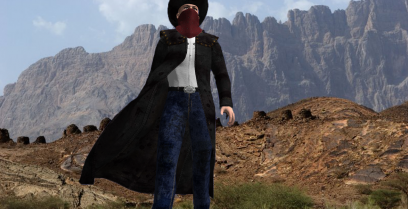 One of the video game industry’s dreams is to have games with visuals that realistically match the carefully planned worlds within which their stories reside. Joe van den Heuvel, who worked in animation and physics development for 10 years, recognized a hole in the last generation of game consoles’ realization of this vision.Simulating textured graphics is computationally expensive, so gaming development companies have to cut corners where they can. Though this is most noticeable in flat background images or blocky polygonal environments, van den Heuvel noted that this problem also manifests itself in a game’s tinier details, like characters’ outfits.“The mindset is that right now cloth is a luxury technology,” van den Heuvel said. “You only put it in if it is necessary or [if you] are trying to boost the level of quality. It is necessary for some developers with distinct [intellectual property] (IP), like Star Wars or Harry Potter, to have robes or cloaks, but a lot of new IPs, like Halo or Gears of War, try to avoid loose clothing.”Van den Heuvel worked with the current generation of game consoles, and in 2009, was able to directly compare the market standards of cloth simulation to what he thought he could achieve.“It isn’t necessarily that existing technologies are wrong, but I’ve managed to change the algorithm around to do it in such a way that instead of expecting the hardware to change, I’ve developed a way to make hardware work for me,” Van den Heuvel explained.Most computers and consoles have graphical processing units (GPUs) that handle most of the texture work. The downside to working with the GPU is that high-end GPUs are cost prohibitive. Including great GPUs in consoles raises prices; not every computer gamer has high-end equipment. Many game engines will even use the CPU to ease the burden on the GPU.
One of the video game industry’s dreams is to have games with visuals that realistically match the carefully planned worlds within which their stories reside. Joe van den Heuvel, who worked in animation and physics development for 10 years, recognized a hole in the last generation of game consoles’ realization of this vision.Simulating textured graphics is computationally expensive, so gaming development companies have to cut corners where they can. Though this is most noticeable in flat background images or blocky polygonal environments, van den Heuvel noted that this problem also manifests itself in a game’s tinier details, like characters’ outfits.“The mindset is that right now cloth is a luxury technology,” van den Heuvel said. “You only put it in if it is necessary or [if you] are trying to boost the level of quality. It is necessary for some developers with distinct [intellectual property] (IP), like Star Wars or Harry Potter, to have robes or cloaks, but a lot of new IPs, like Halo or Gears of War, try to avoid loose clothing.”Van den Heuvel worked with the current generation of game consoles, and in 2009, was able to directly compare the market standards of cloth simulation to what he thought he could achieve.“It isn’t necessarily that existing technologies are wrong, but I’ve managed to change the algorithm around to do it in such a way that instead of expecting the hardware to change, I’ve developed a way to make hardware work for me,” Van den Heuvel explained.Most computers and consoles have graphical processing units (GPUs) that handle most of the texture work. The downside to working with the GPU is that high-end GPUs are cost prohibitive. Including great GPUs in consoles raises prices; not every computer gamer has high-end equipment. Many game engines will even use the CPU to ease the burden on the GPU.
Van den Heuvel solved the cloth simulation problem by using the central processing unit (CPU) to achieve a higher level of processing detail and speed during cloth simulation. Shroud was born in the shift from GPU to CPU.
 Shroud is CloakWorks’ primary focus; it is middleware designed for game developers. Middleware is used for a specific functionality in a game. Different middleware are used by a developer for the physics, sound, or, in Shroud’s case, as a cloth simulation engine.
Shroud is CloakWorks’ primary focus; it is middleware designed for game developers. Middleware is used for a specific functionality in a game. Different middleware are used by a developer for the physics, sound, or, in Shroud’s case, as a cloth simulation engine.
Despite having technology that allows up to a tenfold improvement over other cloth simulation technologies, CloakWorks was not an automatic success. As an independent developer, van den Heuvel had trouble getting access to the developer’s kits that Sony and Microsoft have for their respective consoles.
“It was a sort of catch-22, where developers wanted to make sure [the middleware] would work on the console, and the consoles wanted to know there were games for it,” he said.
Even with access to the console kits, CloakWorks struggled to get funding.
“I wasn’t looking for VC money, but Angel money,” van den Heuvel said. “People who are Angels want to invest in companies close to home so they can monitor their investments. Finding Angels in Chicago who play 3D games themselves was a real challenge.”
So van den Heuvel decided to bootstrap, and so far it has worked out well for CloakWorks.
The release of Kinect, a motion camera that attaches to the Xbox 360, opened up additional opportunities for Shroud to shine. Since then, several companies have turned to Shroud for help building virtual fitting rooms, where the technology not only lets users see how the clothes look on their bodies, but also how the clothes move with them. See Shroud being used as a virtual dressing room at Cisco Live.
Shroud has gotten a lot of traction with top developers in the industry recently, and will be announcing more details soon.
Van den Heuvel said he believes that success for CloakWorks is not just a personal victory, but also one for the Midwest region — specifically Chicago.
“I think the Midwest has a huge potential for the game industry,” van den Heuvel said. “We’ve kind of seen a lull lately without a lot of companies here to form a community. All of these people are going to the great schools here, but then [they] have to go to the coasts or to Montreal because that’s where taxes are lower, or because it is where the other companies are.”
CloakWorks is presenting at Microsoft’s Gamefest in Seattle, August 22 and 23.









